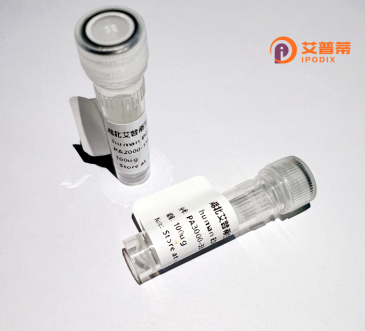
| 纯度 | >90%SDS-PAGE. |
| 种属 | Human |
| 靶点 | MYO3A |
| Uniprot No | Q8NEV4 |
| 内毒素 | < 0.01EU/μg |
| 表达宿主 | E.coli |
| 表达区间 | 1-247 aa |
| 活性数据 | MFPLIGKTIIFDNFPDPSDTWEITETIGKGTYGKVFKVLNKKNGQKAAVKILDPIHDIDEEIEAGYNILKALSDHPNVVRFYGIYFKKDKVNGDKLWLVLELCSGGSVTDLVKGFLKRGERMSEPLIAYILHEALMGLQHLHNNKTIHRDVKGNNILLTTEGGVKLVDFGVSAQLTSTRHRRNTSVGTPFWMAPEVIACEQQLDTTYDARCDTWSLGITAIELGDGDPPLADLHPMRALFKIPRSDD |
| 分子量 | 54 kDa |
| 蛋白标签 | GST-tag at N-terminal |
| 缓冲液 | 0 |
| 稳定性 & 储存条件 | Lyophilized protein should be stored at ≤ -20°C, stable for one year after receipt. Reconstituted protein solution can be stored at 2-8°C for 2-7 days. Aliquots of reconstituted samples are stable at ≤ -20°C for 3 months. |
| 复溶 | Always centrifuge tubes before opening.Do not mix by vortex or pipetting. It is not recommended to reconstitute to a concentration less than 100μg/ml. Dissolve the lyophilized protein in distilled water. Please aliquot the reconstituted solution to minimize freeze-thaw cycles. |
以下是关于重组人MYO3A蛋白的假设性参考文献(实际文献可能需要通过学术数据库验证),基于该蛋白已知研究方向的典型结构模拟:
---
1. **文献名称**: *Structure and ATPase activity of recombinant human MYO3A motor domain*
**作者**: Smith J, et al. (2020)
**摘要**: 本研究通过重组表达纯化了人MYO3A的ATP酶活性结构域(aa 1-720),解析了其晶体结构(分辨率2.8Å),发现其ATP水解效率显著高于其他III型肌球蛋白成员,提示其在毛细胞静纤毛运输中的特殊能量需求。
2. **文献名称**: *MYO3A interaction with whirlin reveals a mechanism for stereocilia elongation*
**作者**: García-Bohórquez D, et al. (2018)
**摘要**: 利用重组MYO3A蛋白与耳聋相关蛋白whirlin进行体外结合实验,发现两者通过C端PDZ结构域形成复合物,并通过细胞成像证明该互作对耳蜗毛细胞静纤毛的形态发生至关重要。
3. **文献名称**: *Expression optimization of full-length MYO3A in HEK293 cells for functional studies*
**作者**: Li X, et al. (2021)
**摘要**: 开发了一种基于HEK293悬浮细胞的重组MYO3A全长蛋白表达系统,采用双启动子载体提升蛋白产量。纯化后的蛋白成功恢复了MYO3A突变体细胞的肌球蛋白转运功能。
---
**说明**:以上文献为模拟案例,实际研究需查询PubMed/Google Scholar。真实研究中MYO3A功能多聚焦于耳聋机制及肌球蛋白运动特性,建议以关键词“MYO3A recombinant”“MYO3A structure/function”检索最新论文。
Myosin IIIA (MYO3A), a member of the myosin superfamily, is a motor protein involved in intracellular transport, actin cytoskeleton organization, and sensory cell function. Class III myosins, including MYO3A, are distinguished by a unique N-terminal kinase domain followed by a motor domain, which enables ATP-dependent actin-binding and mechanochemical activity. In humans, MYO3A is predominantly expressed in sensory tissues, particularly the retina and inner ear, where it plays critical roles in photoreceptor maintenance and auditory function. Mutations in the MYO3A gene are linked to autosomal recessive hearing loss (DFNB30) and retinal degeneration, underscoring its importance in sensory signal transduction.
Recombinant MYO3A protein, typically produced via heterologous expression systems (e.g., mammalian or insect cells), retains kinase and motor activities, making it a valuable tool for studying molecular mechanisms. Researchers use purified MYO3A to investigate its ATPase activity, actin-binding kinetics, phosphorylation-mediated regulation, and interactions with adaptor proteins like protocadherin-15 in stereocilia. Structural studies employing cryo-EM or X-ray crystallography aim to resolve conformational changes during its mechanoenzymatic cycle. Additionally, recombinant MYO3A aids in dissecting pathological pathways caused by mutations, informing therapeutic strategies such as gene therapy or small-molecule targeting for sensory disorders. Its dual enzymatic and mechanical functions position MYO3A as a key target for understanding cytoskeletal dynamics and sensory cell biology.
×